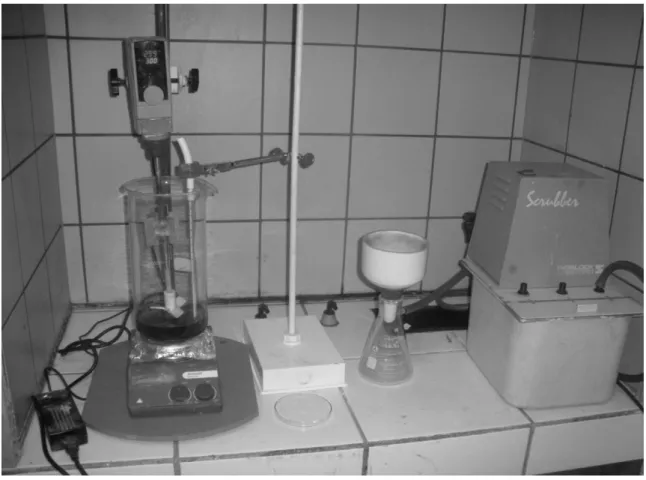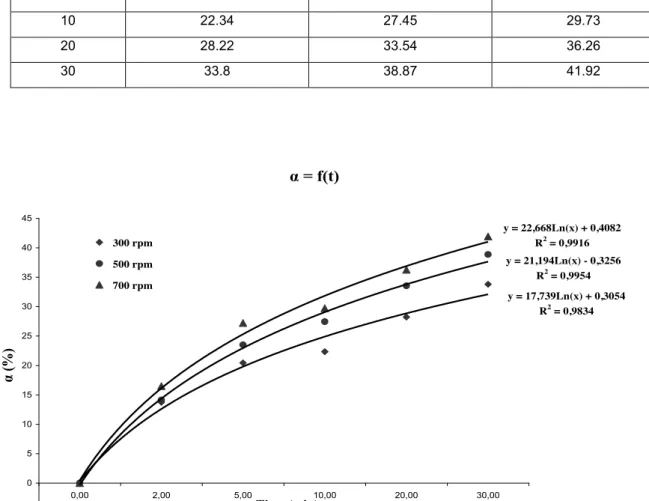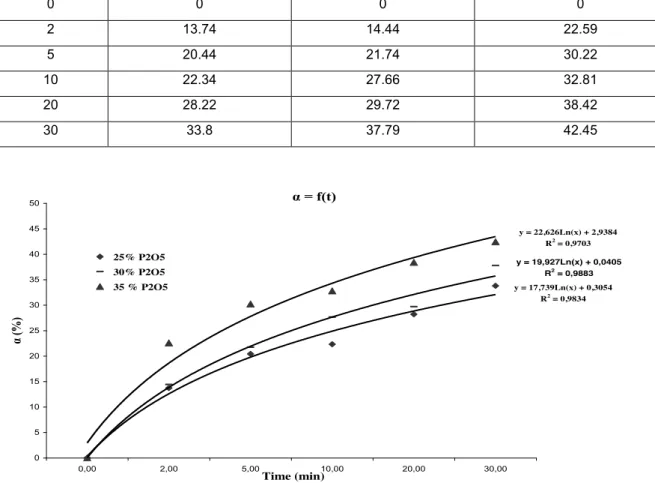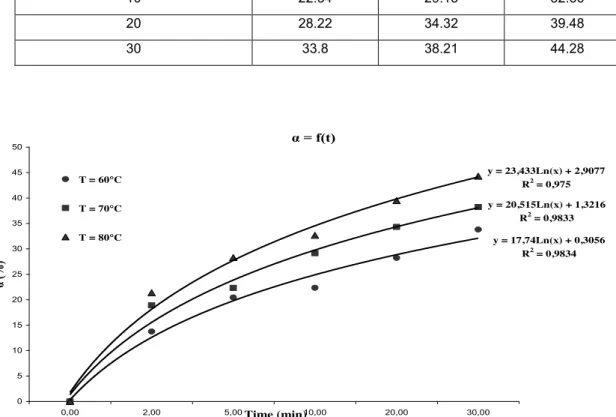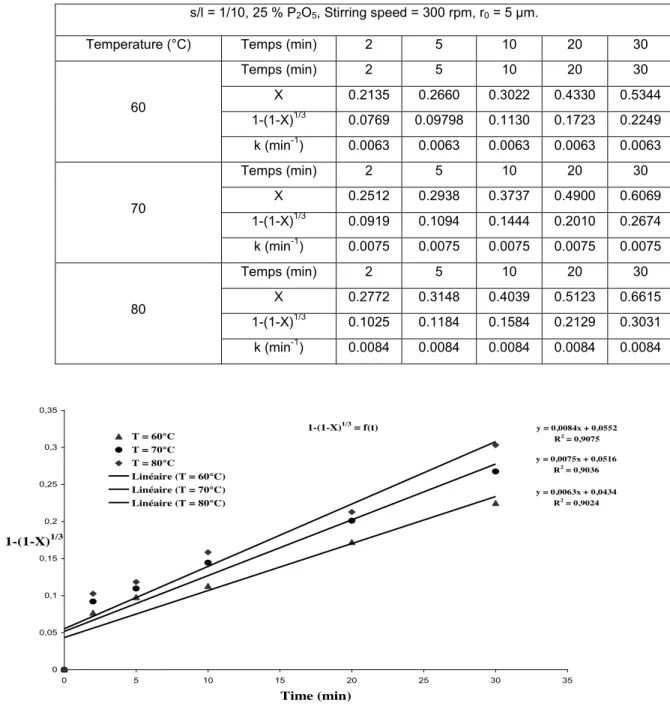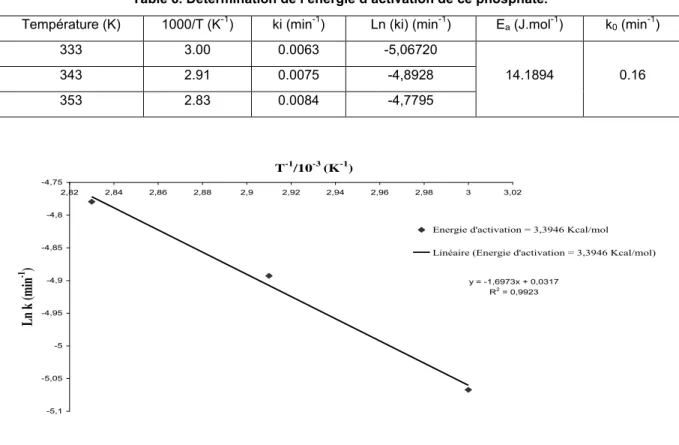HAL Id: hal-01798020
https://hal-mines-albi.archives-ouvertes.fr/hal-01798020
Submitted on 23 Jan 2019
HAL is a multi-disciplinary open access
archive for the deposit and dissemination of
sci-entific research documents, whether they are
pub-lished or not. The documents may come from
teaching and research institutions in France or
abroad, or from public or private research centers.
L’archive ouverte pluridisciplinaire HAL, est
destinée au dépôt et à la diffusion de documents
scientifiques de niveau recherche, publiés ou non,
émanant des établissements d’enseignement et de
recherche français ou étrangers, des laboratoires
publics ou privés.
Kinetic Study of the Dissolution of Tunisian Natural
Phosphate or Francolite in Industrial Phosphoric Acid
Ahmed Chaabouni, Chaker Chtara, Ange Nzihou, Hafed El Feki
To cite this version:
Ahmed Chaabouni, Chaker Chtara, Ange Nzihou, Hafed El Feki. Kinetic Study of the Dissolution
of Tunisian Natural Phosphate or Francolite in Industrial Phosphoric Acid. Journal of Advances in
Chemistry, Khalsa Publications, 2013, 6 (1), pp.908 - 916. �10.24297/jac.v6i1.6585�. �hal-01798020�
Kinetic Study of the Dissolution of Tunisian Natural Phosphate
or Francolite in Industrial Phosphoric Acid
Ahmed CHAABOUNI
a, Chaker CHTARA
b, Ange NZIHOU
C, Hafed EL FEKI
d*
aLaboratory of sciences of materials and environment, Faculty of Sciences of Sfax, Sfax, Tunisia.
Soukra Road km 4 - B.P. n° 802 - 3038 Sfax
E-mail:ahmed_chfss@yahoo.fr
bTunisian Chemical group, Gabes, Tunisia.Tunisian Chemical Group Research Directorate Z.I. BP72 - 6000 - GABES
E-mail:chaker.chtara@gmail.fr
cEngineering School of Mines of Albi-Carmaux, Toulouse, France.
Engineering School of Mines of Albi-Carmaux RAPSODEE Centre Campus Jarlard 81013 Albi CT Cedex 09
E-mail:ange.nzihou@mines-albi.fr
dLaboratory of sciences of materials and environment, Faculty of Sciences of Sfax, Sfax, Tunisia.
Soukra Road km 4 - B.P. n° 802 - 3038 Sfax
E-mail:hafed.elfeki@yahoo.fr
*Corresponding author: E-mail address: hafed.elfeki@yahoo.fr
Abstract
A kinetic study of dissolution of Tunisian natural phosphate or francolite whose particles have a mesoporous texture in industrial phosphoric acid is carried out. Therefore, We focused on the study of the influence of certain parameters that are close to those used in plants producing phosphoric acid which are the stirring speed (300, 500 and 700 rounds per minute), concentration of phosphoric anhydride (25, 30 and 35 percent of P2O5), and the temperature (60, 70 and 80
degrees Celsius); we note that the rate of dissolution of this phosphate rises by increasing the precedent parameters. Because of the complexity of the study of the dissolution of phosphate in mineral acids. Several different published kinetic models giving different expressions of speed versus time. The shrinking core model is the appropriate model used in our work in a solution where there is no calcium sulfate to calculate the rate constant k and the activation energy Ea = 3.3946
Kcal/mol of this phosphate.
Indexing terms/Keywords
1. INTRODUCTION
Tunisia is conquering to the international scale in the field of production of phosphate rock or francolite and is considered among the top four producing countries in the world. In the basin of Gafsa-Tunisia, the most common ore has a sedimentary origin which is the carbonated fluorapatite (or francolite) of general formula [1]: Ca10-n/2[PO4] 6-n(CO3)n(F,OH)2H2O. The carbonate fluorapatite has a crypto-crystalline structure in all Tunisian deposits. The crystal
lattice of the apatite is the seat of several substitutions [2], the Ca ion can be substituted by Mg, Na, and in some rarer cases by Cd. Fertilizers provide nutrients for plants to enable optimal growth. Phosphate fertilizers are obtained from the processing of phosphate rock extracted from the ground. They are increasingly produced in the ore-producing countries [3].
Phosphoric acid is generally the base element in the production of derived products which the most important are phosphate fertilizers which are derived from natural phosphates and phosphoric acid; the process of manufacture of this acid is made by the wet process which consists in the attack of phosphate rock by the sulfuric acid and/or phosphoric acid. These acids can be introduced either simultaneously or successively [4].
The real structure of the apatite in the phosphate rock is still obscure [5]. It is considered as fluorapatite [Ca10(PO4)6F2].
The main reaction in the wet process for producing of phosphoric acid is as follows:
Ca10(PO4)6F2 + 10 H2SO4(aq) + 20 H2O(l) 10 CaSO4.2H2O + 6 H3PO4(aq) + 2 HF(aq) (1)
It is an only empirical formula; the reaction can be better understood by visualization in two distinct stages [6]: Ca10(PO4)6F2 + 14 H3PO4 + 10 H2O 10 Ca(H2PO4)2.H2O + 2 HF (2)
10 Ca(H2PO4)2. H2O + 10 H2SO4 + 10 H2O 20 H3PO4 + 10 CaSO4.2 H2O (3)
In the first step, the fluorapatite is dissolved in a large excess of phosphoric acid to give a solution of monocalcium phosphate [7]. That will happen at any time that there is a deficit in sulfuric acid, and probably occurs momentarily at the interface between the solid phase of phosphate particles and the liquid phase of phosphoric acid. Subsequently, sulfate ions react with monocalcium phosphate, with precipitation of calcium sulphate [8].
The kinetics of chemical reactions that occur in heterogeneous chemical systems presents specific characteristics. The purpose of this study is to determine these specificities, develop the consequences and propose an analyzing methodology for the mechanisms of kinetics of heterogeneous reaction.
The heterogeneous character of the considered systems involves in particular that several processes and reactional steps occur at the interfaces which delimit and separate the various phases of the reaction system. This influence is also reflected by important role of the shape and size of the reactants and reaction products which determine the scope of interfacial zones and their eventual variation.
Industrial applications of the heterogeneous kinetics are many and varied. Before any industrial exploitation of any phosphate, a kinetic study should be done to determine the optimum parameters of work in the plant of production of phosphoric acid. In this work, we are interested in the kinetic aspect of a phosphate during the manufacture of phosphoric acid. As it was reported previously in equation (1), the attack or dissolution of natural phosphate with sulfuric acid is performed in two stages. From equation (2) which corresponds to the transformation of the fluorapatite in monocalcium phosphate which represents the slow stage of the overall reaction (1).It expresses the rate at which the maximum of solubility of the fluorapatite in phosphoric acid is attained because it is a solid-liquid reaction in which the ore intervenes and is neglected however blocking of the attack. For determine the optimum operating conditions that allow to carefully follow the reaction (2) and to be in the standards and the close parameters used in the industry; the parameters that we can vary are: the stirring speed (300, 500 and 700 rpm), the concentration of phosphoric anhydride (25, 30 and 35% P2O5)
and the temperature (60, 70 and 80°C). The kinetic study of dissolution may be deduced practically by the evolution the rate of dissolution, α, depending on the time. The follow of the rate takes place by the rate variation of CaO in the filtrate by the determination of calcium by atomic absorption.
Finally, a mathematical model allows us to determine the parameters involved in the kinetic equation of the phosphate namely the rate constant (k) and the activation energy (Ea).
2. EXPERIMENTAL
The phosphate used comes from the region of Gafsa in Tunisia. Its chemical composition is given in Table 1.
Table 1. Chemical composition (weight percent) of the sample of phosphate.
% P2O5 % CaO % Al2O3 % Fe2O3 % F % MgO % SO3 % CO2 % Corg matter (%) Organic Cd (ppm) % SiO2 % Cl
This experimental part consists to attack a mass of phosphate rock finely crushed (initial mean diameter = 10 microns and SBET = 21.14 m2/g) in industrial phosphoric acid. The experimental setup is shown in Figure 1.
Figure 1. Experimental design of the attack of the phosphate by industrial phosphoric acid.
The device is constituted of a 3 liter beaker being maintained at a constant temperature, measured with a thermometer containing a definite volume of industrial phosphoric acid, is placed on a hot plate until reaching the desired temperature, then adding the appropriate weight of the ore while respecting the solid/liquid ratio selected.
We perform this part by working discontinuously and we do all the manipulations with the same sample of phosphate and the same sample of acid. A mechanical stirrer with adjustable speed allows the homogenization of the reaction medium. The apparatus used is «MSP-2". The stirring device is composed of two mobile of agitation, the one is a propeller which has 3 blade inclined at 45° to try to kept the suspension homogeneous, the other mobile is constituted of four straight blades located on the surface of the slurry which breeze foams and improves the contact air-liquid to obtain a good degassing and cooling for the mixture. A uniform agitation gives a homogeneous medium from which we do a sampling of a defined mass from filtrate after 2, 5, 10, 20 and 30 minute at the end of every manipulating whose we perform filtration by a vacuum pump, the apparatus used is "Scrubber BIOBLOCK SCIENTIFIC". We proceed to a weighing of the filtrate recovered from the filter flask subsequently by sampling from 1.5 to 2 grams of the filtrate and we dissolve it in 10 ml of hydrochloric acid and which is heated on a hot plate at 240°C until the beginning of boil for the determination of calcium content by atomic absorption, the apparatus used is « Perkin Elmer AA 200 »; The solid residue was dried in an oven for 24 hours at 105°C and then weighed.
We represent the kinetics characteristic by the curves giving: α = f(t)
)
(
100
*
%
*
%
*
%
*
100
*
(%)
() ( 0)t
f
CaO
M
CaO
M
CaO
M
ate
MCaOphosph
t
MCaOdissoû
Phosphate P t Ai t fα (%) : Advancement of the reaction.
MCaOdissoût : Mass of CaO provided by the ore and dissolved in the liquid phase.
Mf : Mass of filtrate.
% CaO(t) : The CaO content in the liquid phase at the time t.
MAi : Mass of the initial liquid phase.
% CaO(t = 0) : The CaO content in the liquid phase at the time (t = 0).
Mp : Mass of the phosphate ore.
% CaOphosphate : The CaO content in the phosphate ore.
3. RESULTS AND DISCUSSION
3.1 Effect of stirring speed
The mechanical agitation techniques are a means to create and accelerate the transfer of matter and energy within the same phase or between different phases present. One of the difficulties of the implementation of these techniques is the fact that often we know very little about the actual needs of agitation of chemical or physico-chemical process used industrially. However, we studied the influence of this parameter on the dissolution kinetics of phosphate.
The results of monitoring of the extent of the dissolution by determining the rate of mass conversion versus time are shown in Table 2 and represented in Figure 2.
Table 2. Effect of stirring speed on the dissolution rate of the phosphate.
s/l = 1/10, 25 % P2O5, T = 60°C
Temps (min) α (%) à 300 tours/min α (%) à 500 tours/min α (%) à 700 tours/min
0 0 0 0 2 13.74 14.12 16.47 5 20.44 23.51 27.21 10 22.34 27.45 29.73 20 28.22 33.54 36.26 30 33.8 38.87 41.92
α = f(t)
y = 17,739Ln(x) + 0,3054 R2 = 0,9834 y = 21,194Ln(x) - 0,3256 R2 = 0,9954 y = 22,668Ln(x) + 0,4082 R2 = 0,9916 -5 0 5 10 15 20 25 30 35 40 45 0,00 2,00 5,00 10,00 20,00 30,00 Time (min) α (%) 300 rpm 500 rpm 700 rpmBy varying the stirring speed to values 300, 500 and 700 rpm, we observe from the curves that the dissolution rate increases with the increasing of the stirring speed; in addition we note that the speed attack is very fast in the first two minutes and then it gradually decreases.
3.2 Effect of the concentration of phosphoric acid
We worked on three concentrations; the results are shown in Table 3 and given in figure 3.
Table 3. Effect of the concentration of the acid on the rate of dissolution of the phosphate.
s/l = 1/10, T = 60°C, Stirring Speed = 300 rpm Temps (min) α (%), 25 % P2O5 α (%), 30 % P2O5 α (%), 35 % P2O5 0 0 0 0 2 13.74 14.44 22.59 5 20.44 21.74 30.22 10 22.34 27.66 32.81 20 28.22 29.72 38.42 30 33.8 37.79 42.45 α = f(t) y = 17,739Ln(x) + 0,3054 R2 = 0,9834 y = 19,927Ln(x) + 0,0405 R2 = 0,9883 y = 22,626Ln(x) + 2,9384 R2 = 0,9703 0 5 10 15 20 25 30 35 40 45 50 0,00 2,00 5,00 10,00 20,00 30,00 Time (min) α (%) 25% P2O5 30% P2O5 35 % P2O5
Figure 3. Effect of the concentration of acid on the dissolution rate of the phosphate.
We note that the dissolution rate is proportional to the phosphoric acid concentration. Indeed more the concentration of the acid as P2O5 is low, more the rate of dissolution is slower and more the maximum of dissolution (saturation) is quickly
reaches.
3.3 Effect of temperature
We studied the dissolution of phosphate rock to 3 temperatures, the results of the advancement a function of time are given in Table 4 and represented in Figure 4.
Table 4. Effect of temperature on the rate of dissolution of the phosphate. s/l = 1/10, 25 % P2O5, Stirring Speed = 300 rpm Temps (min) α (%), 60°C α (%), 70°C α (%), 80°C 0 0 0 0 2 13.74 18.89 21.37 5 20.44 22.33 28.28 10 22.34 29.15 32.66 20 28.22 34.32 39.48 30 33.8 38.21 44.28 α = f(t) y = 17,74Ln(x) + 0,3056 R2 = 0,9834 y = 20,515Ln(x) + 1,3216 R2 = 0,9833 y = 23,433Ln(x) + 2,9077 R2 = 0,975 0 5 10 15 20 25 30 35 40 45 50 0,00 2,00 5,00Time (min)10,00 20,00 30,00 α (%) T = 60°C T = 70°C T = 80°C
Figure 4. Effect of temperature on the dissolution kinetics of phosphate rock.
We note that an increase in temperature has a positive effect on the dissolution kinetics of phosphate. Indeed, the temperature promotes generally the dissolution of fluorapatite and the dissolution rate increase. The attack speed is very fast in the first two minutes and then it decreases gradually.
3.4. Choice of the mathematical model
Because of the complexity of the study of the dissolution of phosphate rock in mineral acids. Several different published kinetic models giving different expressions of speed versus time [9-11].
To better represent the conversion rate as a function of time, the suitable mathematical model to represent the dissolution is the shrinking core model [12-20] with integrated expression
1
(
1
X
)
1/3k
.
t
; where X is the fraction reacted, k is the kinetic constant and t time. That equation is represented graphically in Figure 6. The principle of this model is a grain of phosphate of initial size, interfacial area depends only on X. The various curves X = f (t) can be deduced from one to another by changing the variable from t to k.t [12].The calculation becomes simple. Suppose that we are dealing with spheres of initial radius r0, the radius in the time t is r
= r0 - kt, it is also the speed at which decreases the size of the grain.
If we introduce the conversion rate we have: 1 – X = m/m0 = (r/r0)3
If m0 and m are the masses of the spheres at t = 0 and t.
1 – X = (1 – kt/r0)3
We can very easily check the following formula: 1 – (1 – X)1/3 = kt/r 0
This rate law is like an homogeneous reaction in order of 2/3 [12].
The parameters chosen to determine the rate constant and the activation energy are: Stirring speed = 300 rpm, the ratio s/l = 1/10, 25% P2O5 and Temperature = 60, 70 and 80°C.
We determine the rate constants, k, from the curves giving 1 - (1 - X)1/3 as a function of time that must to be linear, the
slopes of the lines providing the rate constants for each temperature. To determine the activation energy, Ea, of this phosphate, we trace log (ki) versus 103.1/T. The corresponding results are given in Table 5 and shown in Figure 5.
Table 5. Determination of the rate constants at different temperatures.
s/l = 1/10, 25 % P2O5, Stirring speed = 300 rpm, r0 = 5 µm.
Temperature (°C) Temps (min) 2 5 10 20 30
60 Temps (min) 2 5 10 20 30 X 0.2135 0.2660 0.3022 0.4330 0.5344 1-(1-X)1/3 0.0769 0.09798 0.1130 0.1723 0.2249 k (min-1) 0.0063 0.0063 0.0063 0.0063 0.0063 70 Temps (min) 2 5 10 20 30 X 0.2512 0.2938 0.3737 0.4900 0.6069 1-(1-X)1/3 0.0919 0.1094 0.1444 0.2010 0.2674 k (min-1) 0.0075 0.0075 0.0075 0.0075 0.0075 80 Temps (min) 2 5 10 20 30 X 0.2772 0.3148 0.4039 0.5123 0.6615 1-(1-X)1/3 0.1025 0.1184 0.1584 0.2129 0.3031 k (min-1) 0.0084 0.0084 0.0084 0.0084 0.0084 1-(1-X)1/3 = f(t) y = 0,0063x + 0,0434 R2 = 0,9024 y = 0,0075x + 0,0516 R2 = 0,9036 y = 0,0084x + 0,0552 R2 = 0,9075 0 0,05 0,1 0,15 0,2 0,25 0,3 0,35 0 5 10 15 20 25 30 35 Time (min) 1-(1-X)1/3 T = 60°C T = 70°C T = 80°C Linéaire (T = 60°C) Linéaire (T = 70°C) Linéaire (T = 80°C)
Figure 5. Determination of rate constants.
From Figure 5, we obtain a line with slope k/r0 for each range of temperature. We note that the straight lines do
not pass through the origin; as the thermal equilibrium is achieved rapidly it can come from by the appearance of another phase in the presence, of either a variation of the form factor at the beginning of decomposition.
Most chemical reactions obey the Arrhenius equation [21-22] and it was used to determine the effect of temperature on the dissolution of phosphate rock:
where Ea is the activation energy, k0 the pre-exponential factor with the same units as the kinetic constant k,
R is the universal gas constant (8.314 cal.K−1.mol−1) and T the absolute temperature (K). Then, the logarithm of the kinetic constant is a linear function of the inverse of temperature. Table 6 shows the values represented in the Arrhenius plot in Figure. 6.
Table 6. Détermination de l’énergie d’activation de ce phosphate.
Température (K) 1000/T (K-1) ki (min-1) Ln (ki) (min-1) Ea (J.mol-1) k0 (min-1)
333 3.00 0.0063 -5,06720 14.1894 0.16 343 2.91 0.0075 -4,8928 353 2.83 0.0084 -4,7795 y = -1,6973x + 0,0317 R2 = 0,9923 -5,1 -5,05 -5 -4,95 -4,9 -4,85 -4,8 -4,75 2,82 2,84 2,86 2,88 2,9 2,92 2,94 2,96 2,98 3 3,02 T-1/10-3 (K-1) Ln k (min -1 )
Energie d'activation = 3,3946 Kcal/mol Linéaire (Energie d'activation = 3,3946 Kcal/mol)
Figure 6. Arrhenius plot.
The activation energy for phosphate dissolution, deduced from the slope of the straight line of the Arrhenius plot, was appreciably lower (14.189 KJ/mol).
The Arrhenius equation may be written in the form :
T
R
e
k
.
14189
16
.
0
The low value of the activation energy which is equal to 3.3946 Kcal.mol-1 gives us an important insight about the kinetically involved model that has been already proposed to simulate the process involved in the study of the mechanisms of dissolution of phosphate rock by the sulfo-phosphoric acids which is probably limited by the diffusion of Ca2+ ions [23-25].
5. CONCLUSIONS
We note that the dissolution rate of the phosphates is faster by increasing the following parameters: temperature in the range (60 - 80°C), the stirring speed in the range (300 - 700 rpm) and the concentration of phosphoric acid in the range (25 - 35 % P2O5).
The dissolution rate is very important for the first 5 minutes. Thereafter, the speed gradually decreases until present an horizontal level.
A mathematical modeling of phosphate ore by the shrinking core model was used to determine the kinetic parameters intervening in the attack namely the kinetic constant k and the activation energy, Ea, that is equals to 3.3946 Kcal / mol.
Finally, a study of the attack of the phosphate in a mixture of phosphoric acid and sulfuric us closer more of industrial attacks conditions and to better appreciate the kinetics of dissolution of this phosphate.
RT
E
e
k
k
a 0REFERENCES
[1] Pettijhon, F. J. and Potter, P. E. 1964. Atlas and glossary of primary sedimentary studies.
[2] Nouah, A. 1992. Les apatites calco-cadmiées : introduction, localisation et extraction du cadmium. Thèse de doctorat de Spécialité, Institut national Polytechnique, Toulouse, France.
[3] Sicre, R. Les engrais, CRDP Nantes.
[4] Becker, P. 1989. Phosphates and Phosphoric acid, Marcel Decker.
[5] SLACK, A. V. 1968. PHOSPHORIC ACID, MARCEL DEKKER. INC, NEW YORK, Volume I, Part I, 129
[6] Waggaman, Wm. H. 1953. PHSPHORIC ACID, PHOSPHATES AND PHOSPHATIC FERTILIZERS. SECOND EDITION, Second Printing, 183.
[7 ] Edwards, R. S. Synthetic Gypsum, its recovery and use, Trans. A.I.C.E., 16 Part 2, (1924) 39-54. [8] Frick, F. F. and Woodman, F. W. 1940. U. S. Part. 2,193,092, Mar. 12.
[9] Avrami, M. 1939. Kinetics of Phase Change.J. Chem. Phys. 7, (1939) 1103.
[10] Yartasi, A., Muhtar Kocakerim, M., Yapici, S., and Ozmetin, C. 1994. Dissolution Kinetics of Phosphate Ore in SO2
-Saturated Water, Ind. Eng. Chem. Res. 33 (1994) 2220-2225.
[11] Abali, Y., Colak, S., and Yartasi, A. 1997. Dissolution Kinetics of Phosphate Rock with Cl2 Gas in Water, Hydrometallurgy,46 (1997) 13-25.
[12] GILOT, B. and GUIRAUD, R. 2004. Cinétique et catalyse hétérogène, Ellipses Edition Marketing S.A., 2004, 155-174. [13] Saeed, M., Hamid, N., Khalique, A., Mansoor, S., and Iqbal, J. 1994. Kinetic study of dissolution of phosphate rock in
aqueous acid solution, Sci. Int. (Lahore), 6(1) (1994) 51-53.
[14] Eguchi, M., Khalique, A., and Nakamura, H. 1982. J. Japan. Inst. Metals, 49 (1982) 1061.
[15] Córdoba, E. M., Muñoz, J. A., Blázquez, M. L., González, F., and Ballester, A. 2008. Leaching of chalcopyrite with ferric ion. Part II: Effect of redox potential, Hydrometallurgy, 93 (2008) 88–96.
[16] Roca, A. Cruells, M. Patiño, F. Rivera, I. Plata, M. 2006. Hydrometallurgy, 81 (2006) 15–23.
[17] Sohn, H.Y. and Wadsworth, M.E. 1979. Rate Processes of Extractive Metallurgy. Plenum, New York, p. 133.
[18] Ballester, A., Verdeja, L. F., and Sancho, J. 2000. Metalurgia Extractiva, vol. I. Fundamentos, Editorial Síntesis, Madrid, 182–189.
[19] Haung, H. H. 1989. Unit Processes in Extractive Metallurgy. Montana College of Mineral Science and Technology. National Science Foundation, USA. Modul 2.
[20] Levenspiel, O. 1979. Ingeniería de las Reacciones Químicas (translated from English version). Editorial Reverté, Barcelona, Spain.
[21] Levenspiel, O. 2004. Capítulo 3: Interpretación de los datos obtenidos en un reactor intermitente, Ingeniería de las reacciones químicas, 3a edición. Editorial Limusa Wiley, México, 38–67.
[22] Logan, S. R. 2000. Capítulo 1: Fundamentos empíricos de la cinética química. Fundamentos de cinética y química. Editorial Addison Wesley, Madrid, 1–22.
[23] van der Sluis, S.,Meszaros, Y., Marchee, W. G. J., Wesselingh, H. A., and van Rosmalen, G. M. 1987. The digestion of phosphate ore in phosphoric acid.
[24] Sergey Dorozhkin, V. 2002. A Review on the Dissolution Models of Calcium Apatites., Progress in Crystal Growth and Characterization of Materials (2002) 45-61.
[25] Gharabaghi, M., Irannajad, M., and Noaparast, M. 2010. A review of the beneficiation of calcareous phosphate ores using organic acid leaching., Hydrometallurgy, 103 (2010) 96–107.

